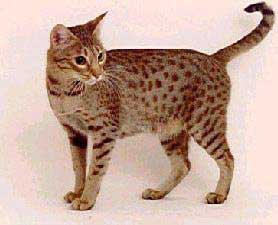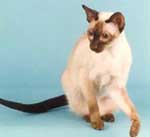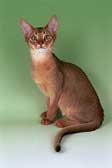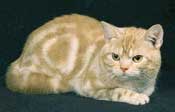Ocicat? That means you crossed to the Ocelot,
right?
No, not at all. This superb, lithe, muscular, spotted cat
has all the look of the wild and may bear a fleeting resemblance to the
Ocelot, but there is not a drop of Ocelot or other wild blood in it.
The beautiful spotted pattern and the squareish muzzle, full
almond eyes and well set ears, sometimes with the bonus of ear tufts,
create the wild look, with the grace of movement in open surroundings,
whether with speed to race cheetah-like from one vantage point to the
next, or with stealth, crouched very low to stalk their prey. Ocicats are
beautiful indeed, but should never be pretty!
Ocicats are highly
adaptable however and do not necessarily require a garden for happiness,
so long as there is plenty of company, preferably human, but also of other
cats of whatever breed and dogs. They exhibit a lively curiosity and
exuberance on home ground, and have equable friendly temperaments, never
showing any aggression. They are dedicated to their owners and highly
intelligent.
It was way back in the sixties when the accident happened. The original Ocicat was the unexpected result of an experimental breeding between an Abyssinian and a Siamese designed to produce an Aby-pointed Siamese, and the name was coined because of the superficial resemblance to an ocelot. The third breed to be involved in the development of the Ocicat was the sturdy American Shorthair. The three very different breeds gave the Ocicat genetic diversity and with it immune system strength.
|
Siamese |
plus |
Abyssinian |
and a little bit of |
American Shorthair |
The first pair of ocicats in the UK, tawnies called Mr Smith and Miss Jones, arrived in 1988 from the Catoninetail Cattery, Indiana. Unfortunately nothing much came of them, and their owner went on to breed Labradors. As I cared for the pair through their six months quarantine, I got the Ocicat bug, and very soon I had my first two pairs of Ocicats: a big Tawny boy, a cinnamon Variant, a cinnamon girl and a Chocolate silver girl. These were followed a year or so later by Grand Champion Catoninetail Kanaka, and L'Belle Tiger Lily, a beautiful Chocolate girl.
At about the same time, Bengals came onto the UK scene and, in
their flamboyant way, quickly took centre stage. I owned one of the
original pairs of Bengals but neutered them following a bad experience
when a kitten that I bred was pushed from one owner to another, pumping
out kittens in order to make money for her successive owners. Umkulu and
Ingwe had long and happy lives here - Kulu left us in August 2011 aged 21,
and Ingwe lived on until May 2012 aged 22.
Ocicats remained in the wings and went along quietly, perhaps a bit
too quietly, and it was not until the Ocicat Club was formed that the
breed began to progress. There were still very few breeders. Kay
Thetford-Kendall (prefix Thedallco) was one of the stalwarts and a
co-founder of the Club; Graeme Slaymaker and Lu Abbs (Launmeadow) were
another pair of breeders who did an enormous amount for the Ocicat in the
initial stages. Their blue spotted male, Thickthorn Fig, became very well
known at the Shows and accrued a huge number of Merit Certificates,
followed by Intermediate Certificates. All of which helped us get
Preliminary Recognition Status in 1997 and then Provisional Status in
2001. Breeders such as Jacky Atkinson (Winnothdale), Carole Green
(Cataristo) and Becki Oldfield (Almuraqat) also contributed to the
breed leading up to Championship status. Our mentor in chief was Mary
Kalal, senior GCCF Judge, without whose help the Ocicat breed might still
be in the background. Mary had three lovely Ocicats herself.
Championship Status was finally granted in October 2004 and took
effect in June 2005. Ocicats. By March 2006 we had one Grand
Champion: Gr. Ch Winnothdale Moele (Chocolate Female) and one Grand
Premier: Gr. Pr Vervain Onthespot, (Tawny Male Neuter). We also had
several Champions and Premiers. Success at both GCCF and TICA Shows has
continued, with many Best of Variety (Foreign) wins. The most recent
outstanding success is that of Imperial Grand Champion Thickthorn Lottie ,
a three year old chocolate female neuter belonging to Stephen Whiting, who
became an Olympian Bronze Medallist in the the short space of 6 months, in
March 2012, against considerable All Breed competition.
Over the years I have imported 19 Ocicats from the USA, most
recently in February 2009 a beautiful Ocicat Classic Auxarcs Homer of
Thickthorn from Barbara Stewart and, because of this, many of the
well-known American Ocicat lines can be found in Thickthorn pedigrees.
This has also allowed for a broad gene pool here in the UK, as far as is
possible in the Ocicat. The breed is fortunate in being able to outcross
Ocicats to Abyssinians in order increase the gene pool. Outcrossing to
Abyssinians is permitted and actively encouraged both here and in the USA.
Through this, we have achieved excellent results at Thickthorn (see Girls
Page) starting with an imported Abyssinian female, Ch. Chereves Wild Honey
of Thickthorn, chosen for the richness of her coat colour. When Honey was
mated with a Tawny Ocicat, she produced a tawny Variant F1 female,
Thickthorn Treacle. In 2005, Treacle was mated to a Chocolate Ocicat and
had a litter of 5: three "mountain lion" variants and two spotted Tawnies
(see the Kitten Page). One of these kittens:
Thickthorn Molly Molasses, did very well at shows, proving how easy it can
be to get excellent Ocicats from such outcrosses, using a little
patience.



